Enzyme-Linked Immunosorbent Assay (ELISA) is a modern molecular technique for the detection of antigen-antibody interaction with the help of an enzyme.
It is one of the sensitive enzyme immunoassay techniques for the detection of the presence of antigen or antibody and quantification as well in the case of clinical diagnosis of many diseases.
Enzyme-linked immunosorbent assay (ELISA) utilizes an enzyme system to show a specific combination of an antigen with its antibody. It is a method of quantifying an antigen immobilized on a solid surface. ELISA uses a specific antibody with a covalently coupled enzyme. The amount of antibody that binds the antigen is proportional to the amount of antigen present, which is determined by spectrophotometrically measuring the conversion of a clear substance to a colored product by the coupled enzyme. The ELISA technique was first conceptualized and developed by Peter Perlmann and Eva Engvall at Stockholm University, Sweden.
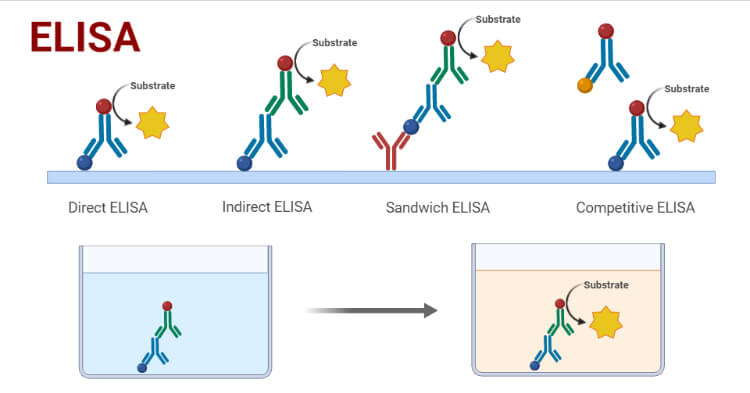
The enzyme system of ELISA consists enzyme which is labeled to a specific antibody or antigen and a chromogenic substrate that is added after the antigen-antibody reaction. The substrate is hydrolyzed by the enzyme attached to antigen-antibody complexes. An ELISA test uses components of the immune system (such as IgG or IgM antibodies) and chemicals for the detection of immune responses in the body. The ELISA test involves an enzyme (a protein that catalyzes a biochemical reaction). It also involves an antibody or antigen (immunologic molecules). Examples of the uses of an ELISA test include diagnosing infections such as HIV (human immunodeficiency virus) and some allergic diseases like food allergies. ELISA tests are also known as immunosorbent assays.
Following the antigen-antibody reaction, chromogenic substrate specific to the enzyme (o- phenyldiamine dihydrochloride for peroxidase, p-nitrophenyl phosphate for alkaline phosphatase, etc.) is added. The substrate is acted upon (usually hydrolyzed) by an enzyme attached to the antigen-antibody complex to give color change. The color in the reaction can be read visually or The reaction is detected by reading the optical density (estimated colorimetrically) using a microassay plate reader i.e. ELISA reader. Usually, a standard curve based on known concentrations of antigen or antibody is prepared from which the unknown quantities are calculated.
The antigen or antibody is coated on a solid surface such as in a plastic tube or well of a microtiter plate. Thus, after the antigen and antibody have combined (Antigen-antibody complex formed) they remain firmly attached to a solid surface during subsequent washing stages.
Enzyme immunoassays (EIAs) can be used for the detection of either antigens or antibodies in serum and other body fluids of the patient. In EIA techniques, antigens or antibodies labeled with enzymes are used. Alkaline phosphatase, Horseradish peroxidase, and β-galactosidase are the enzymes used in the EIA tests.
Interesting Science Videos
ELISA Requirements
- Coated plates (Microtitre plates): Commonly used ones are 96 well polystyrene plates. Coated with antigens or antibodies at the bottom of the well.
- Sample diluents: To dilute the sample before application in some cases of ELISA test.
- Wash Buffers: Help to wash away the unrequired contaminants and unbound antigens or antibodies. Eg. Triphosphate buffer (ph 7.40) and detergents such as Tween-20.
- Enzyme-linked Antibodies: For this, most common enzymes used are
- AP(Alkaline Phosphatase)
- HRP(Horseradish Peroxidase)
- Substrates: Specific chromogenic substrates are used for the respective enzymes used. Commonly used substrates are o-phenylene diamine for HRP enzyme and p-nitrophenyl phosphate for AP enzyme.
- Stop solution: It stops the enzyme and substrate reaction. It can be acids such as sulphuric acid.
ELISA Principle
Antigens and antibodies react specifically to form the Ag-Ab complex. Antibodies can be linked or attached to enzymes. The enzyme-linked antibodies can modify the specific substrates used to produce a color change within the preparation. The enzyme activity is measured with a colorimeter in a specific wavelength of light to determine the magnitude of the infection in the patient.
Types of ELISA
They are of mainly four types:
- Direct ELISA
- Indirect ELISA
- Sandwich ELISA
- Competitive ELISA
1. Direct ELISA
It is the simplest and quickest of all other types of ELISA. A single enzyme-linked antibody is used which directly interacts with the antigen present in the sample.
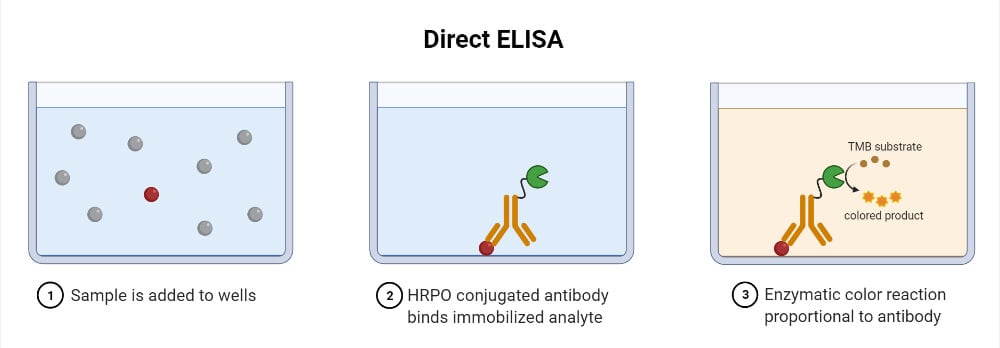
Direct ELISA Procedure
- Addition of sample(containing antigen) to the well of the microtitre plate
- Antigen gets adsorbed to the surface of the well.
- Washing to remove unbound antigens
- The addition of an enzyme-linked antibody that with the antigens if present.
- Washing to remove unbound antibodies
- Addition of chromogenic substrate
- Visualization of color change and result interpretation
Direct ELISA Applications
- Used in the identification of biomolecules.
- Also for the diagnosis of infections of Mycoplasma bovis
2. Indirect ELISA
- Developed in 1978.
- It is the most popular type of ELISA in use.
- Antibody detection is carried out in indirect ELISA. A secondary antibody linked with the enzyme is used.
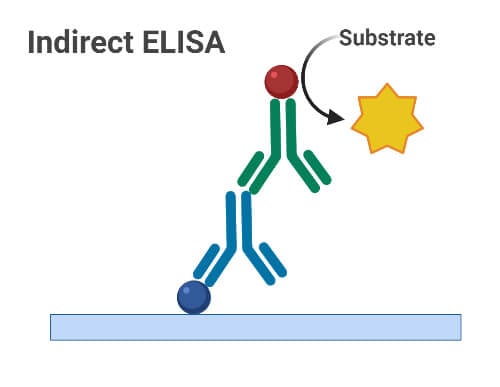
Indirect ELISA Procedure
- Addition of known antigens specific to the antibody of interest
- Careful washing to remove unadsorbed antigens or some adsorbed contaminants.
- Addition of serum samples to their respective wells
- If there is the presence of specific antibodies, they will bind to the antigens.
- Wash again.
- Addition of enzyme-linked secondary antibodies to the well
- Wash again
- Addition of substrate
- Visualization of color change and result interpretation
Indirect ELISA Applications
- Detection of HIV, Rubella, Dengue viruses, etc.
- To detect certain drugs in serum.
3. Sandwich ELISA
- Developed in 1977.
- Detection of antigens.
- Two different antibodies i.e. capture antibodies(for attachment sample antigens) and enzyme-linked secondary antibodies are required.
- The antigen of interest first binds with the capture antibodies and then the secondary antibodies bind with the epitope antigen forming a sandwich-like structure with antigen in between antibodies.
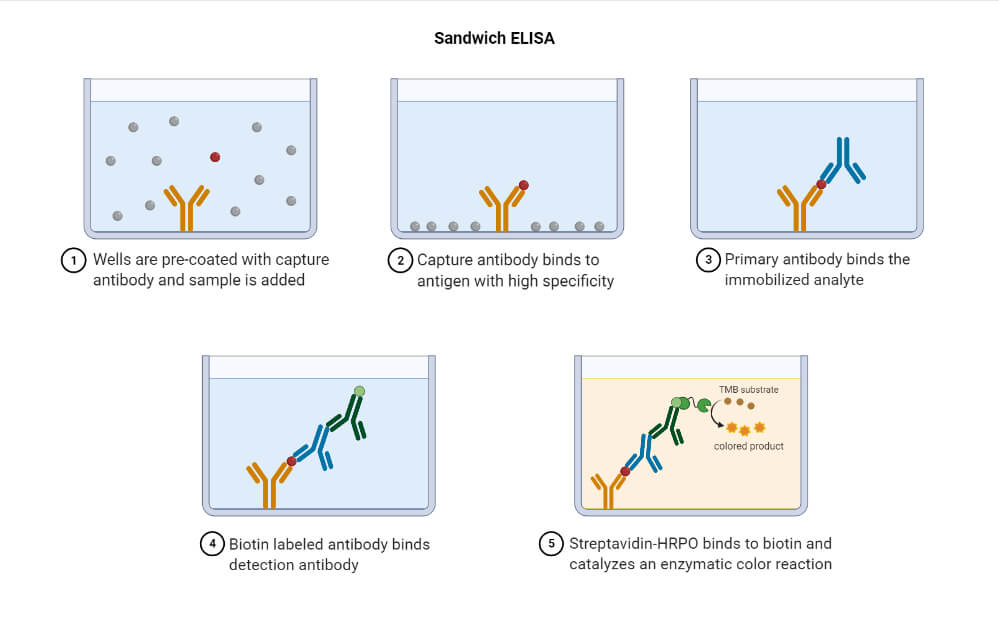
Sandwich ELISA Procedure
- Addition of capture antibodies in the microtitre well
- Washing
- Addition of serum sample(containing antigen) in the well
- Washing
- Addition of enzyme-linked antibodies in the well
- Washing
- Addition of substrate
- Visualization of color development and result interpretation
Sandwich ELISA Applications
- Mainly used for detection of Rotavirus and enterotoxins of fecal E. coli.
- Pregnancy tests kids are based on this technique.
4. Competitive ELISA
- Developed in 1976.
- Detection of antibodies.
- The basic concept of this type is that there occurs competition of binding between the sample antibodies(if present) and enzyme-linked secondary antibodies to the antigens. If the sample contains specific antibodies of interest, they will bind to the antigens and won’t allow enzyme-linked antibodies to bind with antigens which are then washed away. Hence after the addition of substrate, there won’t be a color change indicating a positive test and vice-versa.

Competitive ELISA Procedure
- Addition of HIV antigens in the microtitre well
- Washing
- Addition of serum sample
- Washing
- Addition of enzyme-linked HIV specific antibodies
- Washing
- Addition of substrate
- Visualization of color change and result interpretation
Competitive ELISA Application
- Mainly used for the detection of HIV
ELISA Result Interpretation
Qualitative interpretation i.e. presence or absence of antigen is done by visualizing the color change in the solution.
If the Ag-Ab reaction takes place and bound enzyme linked with antibodies remain in the solution, they will modify the substrate, and color change can be seen.
Quantitative interpretation i.e. concentration of antigen or antibody can be identified by measuring the optical density of the solution with the help of an ELISA reader spectrophotometer.
Then optical density vs concentration curve is prepared for both the standard sample and unknown sample and compared to determine the concentration in the unknown sample.
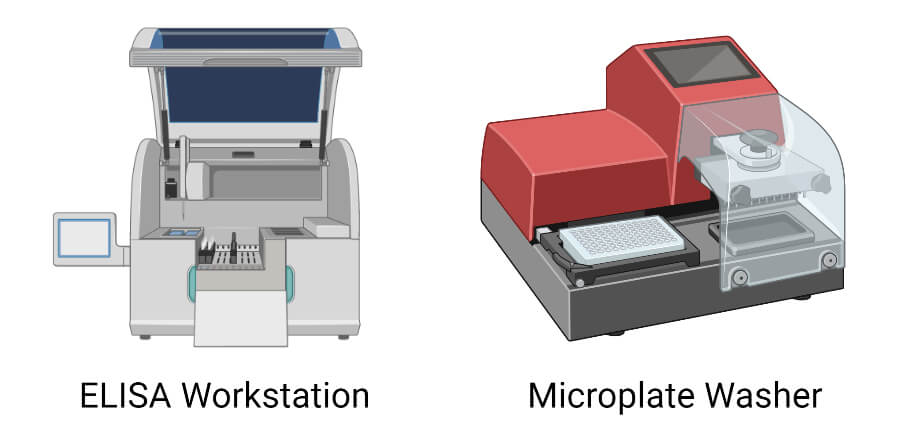
ELISA Applications
- It is one of the most sensitive and effective methods for the detection of different viral, bacterial, and fungal infections.
- Screening test for HIV infection.
- Different EISA test kits are available for the detection of dengue fever, TB, and Hepatitis B infections.
- Pregnancy test kits based on ELISA are also available.
- Qualitative and quantitative estimation of various proteins, hormones, toxins, etc.
- Also used in the detection of different food allergens.
Advantages of ELISA
- Protocols are simple.
- Highly specific and sensitive
- Highly efficient
- Low-cost reagents
- No requirement of any unsafe materials such as radioactive substances as in Radio Immunoassay
Limitations of ELISA
- Work-Intensive
- Preparation of enzyme-linked antibodies can be difficult and expensive.
- Since the antibodies are unstable so for transport and storage proper refrigeration is required.
References
- Sakamoto, S., Putalun, W., Vimolmangkang, S., Phoolcharoen, W., Shoyama, Y., Tanaka, H., & Morimoto, S. (2018). Enzyme-linked immunosorbent assay for the quantitative/qualitative analysis of plant secondary metabolites. Journal of Natural Medicines, 72(1), 32. https://doi.org/10.1007/S11418-017-1144-Z
- Goldsby R.A., Kindt T.J., Osborne B.A., (1999) Kuby Immunology, 4th edition, W.H.Freeman & Co Ltd., pg. 148-149
- Parija S.C., (2009), Textbook of Microbiology and Immunology, 2nd edition, Elsevier, a division of Reed Elsevier India Private Limited, pg. 112-113
